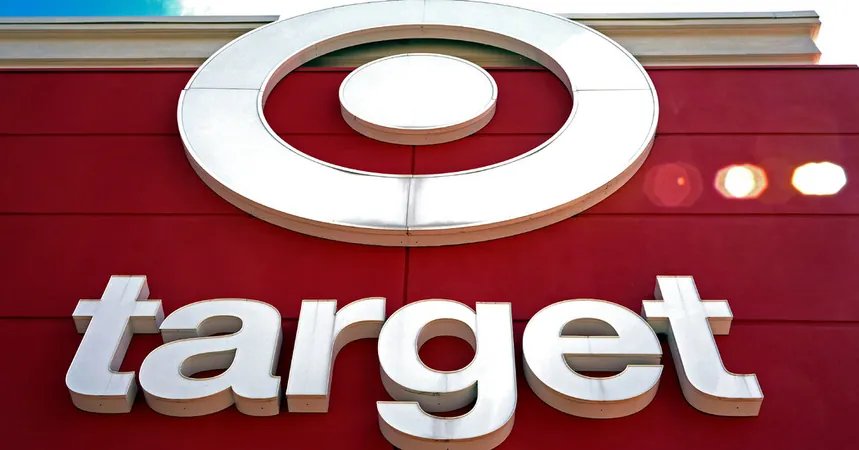
Target Stock Takes a Major Hit: What This Means for Holiday Shopping Season
2024-11-20
Author: Kai
Target’s Disappointing Earnings Report
Target has sent shockwaves through Wall Street following a disappointing earnings report that highlighted declining sales, reduced profits, and a concerning increase in unsold inventory. With the crucial holiday shopping season on the horizon, the retailer's cautious outlook raises significant red flags for investors and consumers alike.
Stock Market Reaction
In early trading, Target's stock plummeted by over 20 percent, marking one of the steepest daily declines in its history. This recent downturn follows another grim earnings report from mid-2022 and echoes the notorious 'Black Monday' crash of October 1987.
Sales Performance Overview
In the last quarter, Target experienced a 1.9 percent drop in sales compared to the same period last year, although online sales saw a notable surge of 10.8 percent. Despite this digital uptick, the company anticipates that sales will remain flat in the upcoming quarter and has notably amended its full-year profit forecast—an adjustment that nearly reverses a promising increase touted just three months prior.
Management’s Outlook
Target's chief financial officer, Jim Lee, described this conservative approach as 'prudent,' emphasizing the need for 'swift and disciplined action' to position the company favorably for the holiday season and beyond into 2025. While recent efforts to enhance customer experience had attracted shoppers to stores, the latest earnings setback indicates that challenges are far from resolved. CEO Brian Cornell acknowledged that the retailer is navigating a 'volatile operating environment.'
Implications for Holiday Shopping
The disappointing earnings report coincided with key shopping periods, including back-to-school and Halloween, which typically serve as precursors for consumer spending trends leading into Thanksgiving and Christmas. Analysts are closely monitoring these seasonal indicators, as they can predict consumer behavior during the pivotal holiday shopping weeks.
Comparative Analysis with Walmart
Unlike Target, its main competitor, Walmart, recently reported robust earnings, exceeding expectations and even raising its full-year forecast. Walmart's substantial size and diverse product offerings have reinforced its status as a bellwether of U.S. consumer behavior, reflecting resilience amidst economic headwinds. The retailer’s investment in delivery and online shopping capabilities has allowed it to attract a broad customer base, regardless of income level.
Target's Pricing Strategy
Target's recent focus on slashing prices in a bid to draw in shoppers affected by inflation has not yielded expected results. The company announced plans to reduce prices on over 2,000 items, including popular goods such as Crisco vegetable oil and cat litter, and aims to cut down prices on 10,000 items by year-end. Despite a 2.4 percent increase in shopper traffic, the average spending per visit dropped by 2 percent.
Challenges Ahead
During an analyst call, Cornell pointed out 'unique challenges' faced this quarter, including a preemptive buildup of inventory to mitigate disruptions from a looming East Coast port worker strike. Walmart also reported that this labor dispute had an impact on its own sales and profits.
Changes in Consumer Behavior
Target's executives highlighted a notable slowdown in sales for higher-margin discretionary categories—like apparel and home decor—which have been impacted as consumers shift spending toward less expensive items, such as candles and vases, rather than larger purchases like televisions.
Future Optimism
Amidst these challenges, Target's leadership is resolute that consumer behavior will eventually pivot. However, compared to Walmart, Target's business structure is more reliant on discretionary items and has a relatively smaller grocery component, a sector that maintains consistent shopper footfall. Roughly 50 percent of Target's revenue stems from discretionary categories, while groceries comprise about 60 percent of Walmart’s revenue.
Looking Forward
Mr. Cornell remains optimistic about a rebound in the home category over time, asserting, 'We know that America is going to buy sporting goods and toys,' underlining a belief that despite current macroeconomic challenges, consumer spending will recover.
Conclusion
As the holiday season approaches, all eyes will be on how Target navigates these turbulent waters and whether strategic adjustments can lead to a turnaround in sales performance. Will shoppers continue to turn away from discretionary spending, or is there a light at the end of the tunnel for one of America's most recognizable retail brands? Stay tuned!


 Brasil (PT)
Brasil (PT)
 Canada (EN)
Canada (EN)
 Chile (ES)
Chile (ES)
 España (ES)
España (ES)
 France (FR)
France (FR)
 Hong Kong (EN)
Hong Kong (EN)
 Italia (IT)
Italia (IT)
 日本 (JA)
日本 (JA)
 Magyarország (HU)
Magyarország (HU)
 Norge (NO)
Norge (NO)
 Polska (PL)
Polska (PL)
 Schweiz (DE)
Schweiz (DE)
 Singapore (EN)
Singapore (EN)
 Sverige (SV)
Sverige (SV)
 Suomi (FI)
Suomi (FI)
 Türkiye (TR)
Türkiye (TR)